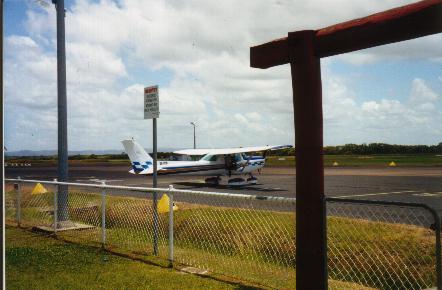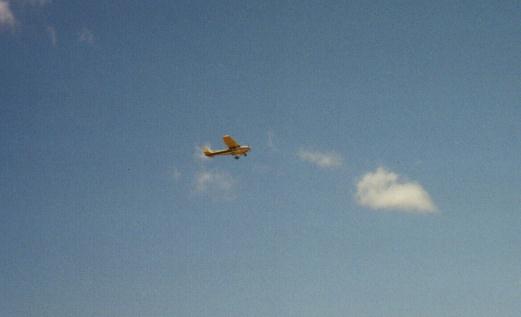A Circuit around Redcliffe Areodrome
A not to scale drawing of the circuit area
A Circuit around Redcliffe Areodrome
A not to scale drawing of the circuit area
For over a year now, I have been learning to fly at the Redcliffe Aerodrome. Most of this is due to the kindness of my Grandfather, who I thank very much, for he saw how much I loved aviation and flying. Most of the training has taken place in the circuit area, which as shown in the map above. The circuit is used to get training pilots as much experience as possible in taking off, landing, climbing, descending and using radio equipment. I have spent about 8 months flying in there, which included 2 hours flying solo. Many people ask me what it is like to fly, and now I am going to explain everything I do and think as I go around a circuit.

When you first get to the aerodrome, papers and sign out sheets must be completed, as well as usually a pre-flight briefing. Then its out to the plane for a pre-flight inspection. This is done to make sure the plane has sufficient fuel, oil and is in good flying condition. The whole plane is checked, and although its pretty boring, it has to be done every time properly, and is now second nature to me. If there is less than 50 litres fuel aboard, we re-fuel the plane before the flight. This again is pretty annoying, for the last person should have filled the plane up, but without fuel, we would crash into the sea somewhere. At least now I can re-fuel the plane without spilling avgas everywhere. But anyway.....


Two different days, two different conditions, but still
the preflight goes on
Once you get inside the plane, you go through all the checks, making sure all electrics, navigational devices etc. are working. Then its the taxiing radio call, and then your off down the taxi way, down to the holding point. I often get told I taxi too fast, but still, it feels pretty damn slow. More checks are done in the holding area, 10 degrees of flap is selected, then you lookout to make sure no one is coming into land. Once everything is clear, you make another radio call telling everyone you are on the runway, about to take off, and where you are headed. This is one of my favorite times of the flight as you line the plane up straight on the end of the runway. Most of the time, we use runway 07, so I will explain it from that circuit's point of view (the other runway is 25).
Wheels are straight, then you count 1,2,3, as you put full throttle on. The 4 cylinder starts revving at about 2500 rpm (which is its top rpm), and once you hit 50 knots on the air speed indicator (ASI), you pull back on the control lever, lifting all three wheels off the ground. At 50 feet, if you haven't closed the door properly, it will pop open, which has occurred to me twice. Not a bad feeling looking out at the ground a couple of hundred feet above sea level, with only one safety harness stopping you from falling out.

I'm in there somewhere - just after take off
At 200 feet, you put all flaps up, but not the wheels (my plane's wheels don't go up). The plane jerks around a bit, but once its trimmed out, you keep climbing at no less then 65 knots. About now your over water, and I look back out of the rear window to make sure I haven't drifted off the runway line too much. Your almost over Redcliffe when at 500 feet, you have a good look for planes, then do a 15 degree banked turn to the left. You stop once you almost are looking straight at the Glasshouse mountains, and you keep climbing at 65 knots. About now you look out at the tiny boats in the bay, before leveling out at 1000 feet, decreasing power back to 2300 rpm. Another left hand turn takes place, this time at 30 degrees bank, which then puts you on downwind leg.
Once on downwind you have a good look to see who is on the runway, or turning in front of you, or leaving the circuit area. Before you have time to enjoy the scenery, you are doing you downwind leg checks - brakes, under carriage, mixture rich, fuel on, harnesses and hatches secure. When you are at the end of the downwind leg, you make another radio call, telling everyone you are about to turn onto base leg. Once this is done, and I am about in line with a large shed a couple of miles to my left, I drop the rpm down to 1500, and commence another 30 degree banked turn, keeping the nose up so I don't lose too much altitude, and so my airspeed decreases into the lowering flaps range. Carby heat is also applied, so that the engine doesn't freeze up due to lack of engine temperature at low rpm.
Once I have then leveled out again, and the ASI is in the white range, 20 degrees of flap is lowered to increase drag, slowing the plane down, but decreasing the stall speed (so the plane won't stall as easily if I start day dreaming). You descend at 70 knots, usually aiming at Brisbane city on the horizon, or the Hornibrook Bridge. You aim to be at 500 feet before turning onto base leg. I usually turn onto base leg at a 30 degree turn, once I am above that shed I talked about above.
Now you try to keep the start of the runway on the same spot on your windscreen during the rest of the descent, which stops you 'sinking' or undershooting/overshooting the runway. I then lower full flaps - 30 degrees, to slow the plane down more, and I try to keep the ASI around 63-70 knots (75 knots if it is a really windy day). You are then toggling the throttle forward and back to try and keep at this decent, and so that you don't start sinking. About half way down final leg, I look to my right at the gum trees, by now I am usually 200-300 feet above sea level, and above the gum trees. They are kind of my reference point to see if I am descending too fast or too slow. About now I take the carby heat off again.
Now it starts getting really turbulent, and by now you should have looked at the wind sock to see which way the wind is blowing. You keep aiming for the numbers 07 on the runway, and your heart beat increases. You are just clearing the mangroves, as you close the throttle (therefore no power) and holding back on the control lever as you are just hovering above the runway. Every time it sinks, you pull back a bit more to 'flare' until the back wheels touch the runway, and then you softly (well, I try anyway) put the front wheel on the deck. If you are headed around for another circuit, you raise the flaps to 10 degrees, apply full power, and head around for another lap. Otherwise, you are on the brakes, keeping the control lever pulled back to keep the weight off the front wheel. You then taxi back to the 'planepark'. You then go through the shut down sequence, checking the magnetos etc., then shutting the plane down. Suddenly you are back on solid ground and in the real world again, and all ready miss being up there.
Some other pictures you may find interesting:
C-152
cockpit
Picture
from inside plane before take off
The
view I see while coming in to land
Flying
over the aerodrome at 1500 feet
A
view of the whole aerodrome